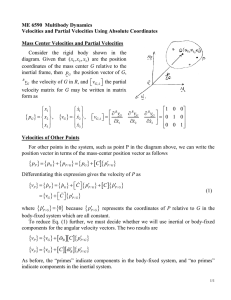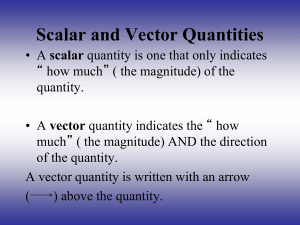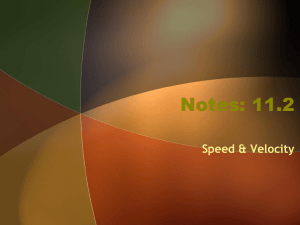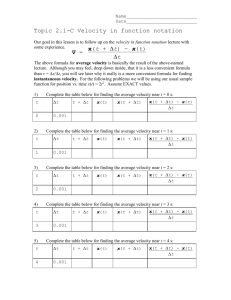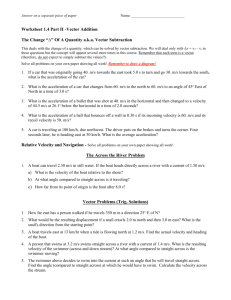03_Relative Velocities
advertisement
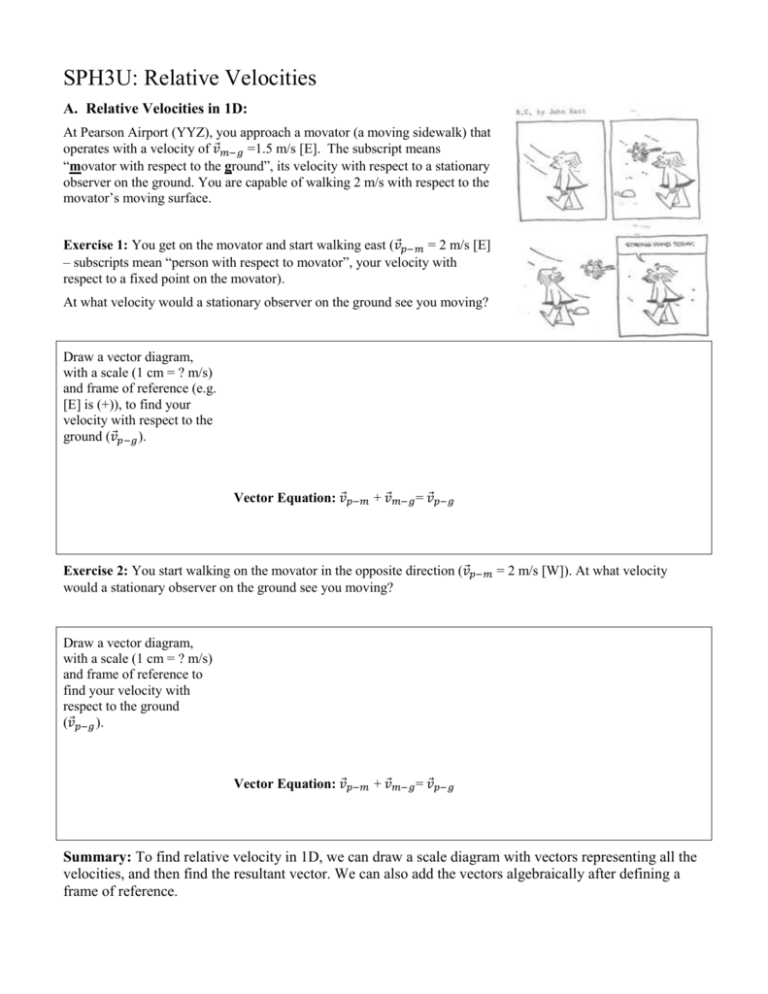
SPH3U: Relative Velocities A. Relative Velocities in 1D: At Pearson Airport (YYZ), you approach a movator (a moving sidewalk) that operates with a velocity of 𝑣⃗𝑚−𝑔 =1.5 m/s [E]. The subscript means “movator with respect to the ground”, its velocity with respect to a stationary observer on the ground. You are capable of walking 2 m/s with respect to the movator’s moving surface. Exercise 1: You get on the movator and start walking east (𝑣⃗𝑝−𝑚 = 2 m/s [E] – subscripts mean “person with respect to movator”, your velocity with respect to a fixed point on the movator). At what velocity would a stationary observer on the ground see you moving? Draw a vector diagram, with a scale (1 cm = ? m/s) and frame of reference (e.g. [E] is (+)), to find your velocity with respect to the ground (𝑣⃗𝑝−𝑔 ). Vector Equation: 𝑣⃗𝑝−𝑚 + 𝑣⃗𝑚−𝑔 = 𝑣⃗𝑝−𝑔 Exercise 2: You start walking on the movator in the opposite direction (𝑣⃗𝑝−𝑚 = 2 m/s [W]). At what velocity would a stationary observer on the ground see you moving? Draw a vector diagram, with a scale (1 cm = ? m/s) and frame of reference to find your velocity with respect to the ground (𝑣⃗𝑝−𝑔 ). Vector Equation: 𝑣⃗𝑝−𝑚 + 𝑣⃗𝑚−𝑔 = 𝑣⃗𝑝−𝑔 Summary: To find relative velocity in 1D, we can draw a scale diagram with vectors representing all the velocities, and then find the resultant vector. We can also add the vectors algebraically after defining a frame of reference. B. Relative velocities in 2D You are the pilot of a small aircraft leaving the Island Airport (YTO). After climbing to 12 000 ft you set the plane cruising with an airspeed of 𝑣⃗𝑝−𝑎 = 400 km/h [W] (airspeed refers to the speed of the plane with respect to the air). You are advised by ground control of strong winds and rough weather conditions. Complete the chart to show the effect of different winds (𝑣⃗𝑎−𝑔 = speed of air with respect to the ground) on your flight. For each situation draw a vector diagram for the velocities. Measure and label your resultant velocity with respect to the ground (𝑣⃗𝑝−𝑔 ). Draw a scale vector diagram showing the path the plane follows and its displacement relative to the start in Toronto after 2.5 hours of travel. Indicate your scales. Wind 100 km/h [W] 150 km/h [N] 120 km/h [E] 200 km/h [S20oE] Velocity Diagram (1 cm = ) Displacement (1 cm = ) SPH3U: Relative Velocities - Homework You are driving a boat across a river starting from Dock 1. The current runs due north at 2 m/s and the boat travels at 5 m/s relative to the water. Direction of Boat Vb g (velocity of boat relative to ground) d after 10 s [E] 2 [E 30o N] 1 50 m [E 24o S] 1. According to your chart which way should you point the boat if you wish to travel to the dock on the other side of the river? 2. In which situation do you have the largest velocity relative to the ground? 3. In which situation will you cross the river in the least time? Careful! Textbook Questions: pg. 114, #35, 41, 43

